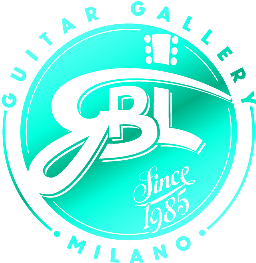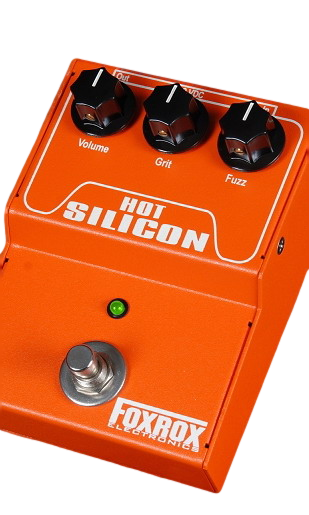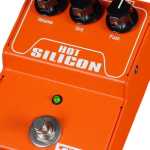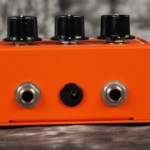Hot Silicon Fuzz (HSF) is the same Hot Silicon previously available as a FuzzCard for Captain Coconut 2. HSF uses a pair of high-gain BC109C silicon transistors, just like many of the original silicon FuzzFaces, and all of the Crest Audio reissues from the late ’80s.
The Foxrox Hot Silicon Fuzz is based on the most famous fuzz of all, the Dallas Arbiter FuzzFace. The FuzzFace has gone down in history as one of the most erratic, but coolest sounding fuzz effects ever made. They all sounded slightly different due to a number of variables including temperature, transistor gain and quality, battery level and pickup output levels. FuzzFaces could sound dull, bright, smooth, gritty, and sometimes so choppy that they were unusable. There were two different types of FuzzFaces, the original PNP Germanium version and the NPN Silicon version which followed. The Foxrox Hot Silicon Fuzz is based on the NPN Silicon FuzzFace.
HSF specializes in the hotter, brighter side of Fuzz. The transistors are high gain silicon (BC109C), which are hand picked and custom matched for the best sounds. The sound is more high-endy than other versions, and there is no shortage of gain and sustain at normal playing levels. At high gain settings, it can get unruly, breaking into oscillation and noise. Under certain conditions it can even pick up radio broadcasts, although measures have been taken to avoid this. It can also oscillate when fed by a wah wah pedal. While these might seem like bad things they are part of what it takes to recreate certain classic sounds, including many of the live Hendrix recordings from 1969 / 1970 such as Woodstock, Band of Gypsies and Isle of White. With the right settings, this fuzz can be tamed, but the out-of-control aspect is what makes it unique. If you would prefer that your wah pedal does not interact with the fuzz, check out the Foxrox Wah Retrofit.
Controls
- Fuzz allows you to back off on the intensity of the fuzz. This is useful when looking for special vintage sounds and when driving more overdrive stages. This is also great if you want to dial in some wimpy fuzz tones for effect. If you want the fuzz to clean up when you role back your guitar’s volume knob, back off a little on the Fuzz control. You can dial in a massive range of great sounds just by playing around with the Grit control, the Fuzz control, and your guitar’s volume and tone controls.
- Grit makes Hot Silicon different from other similar fuzz boxes. This knob allows you to fine tune the attack, tone and fuzz level. The control is subtle, but very effective. As a continuous control, you can dial in the exact sound you want. Here are some examples of what to expect as you try out different Grit settings:
- Counter clockwise: Dull loud tone. Sounds great when overdriving a tube amp, or pushing an already overdriven amp over the top. This is a very fat fuzz sound that can be heard on lots of old recordings from the ‘60s and ‘70s.
- Middle: Even tone with lots of fuzz and sustain. This is the most user-friendly of all the settings. The tone is very round, without sputter. If you like to clean up your sound by turning down your guitar’s volume knob, the Grit control should be set between 10:00 and 1:00.
- Clockwise: Clipped, farty and burnt out. If you’re looking for some of the nastier fuzz sounds, experiment with Grit settings in the 2:00 to 5:00 (max) area. The sound gets very choppy while you pick and the sustain trails off abruptly. This sound can be pretty ugly at times, but it’s great for reproducing certain vintage tones that originally occurred due to unmatched transistors or drained batteries. Extreme Grit settings sound great when your amp is turned up loud. Stand near your amp and play around with the feedback.
- Volume – The Hot Silicon Fuzz is set up to have more than enough gain for those who like it LOUD. Changes in the Grit control have a direct effect on the output level, so you may need to make some volume adjustments while dialing in your sound.
- Input Trim – Hot Silicon Fuzz includes an internal trim pot that adjusts the amount of loading at the input stage.
| Inception Date | December, 2005 |
| Dimensions | Width = 3.85″ Depth = 5.15″ Height = 3″ (max) |
| Unit Weight | 1 lb. 8 oz. |
| Voltage | 9 Volts DC (via 9V battery or external power) |
| Current Draw | 12mA |
| Power Connection | 2.1mm, Center = NEG (FX standard) |
| Signal Switching | True bypass with LED |
| Owner’s Manual | DOWNLOAD HSF MANUAL |




